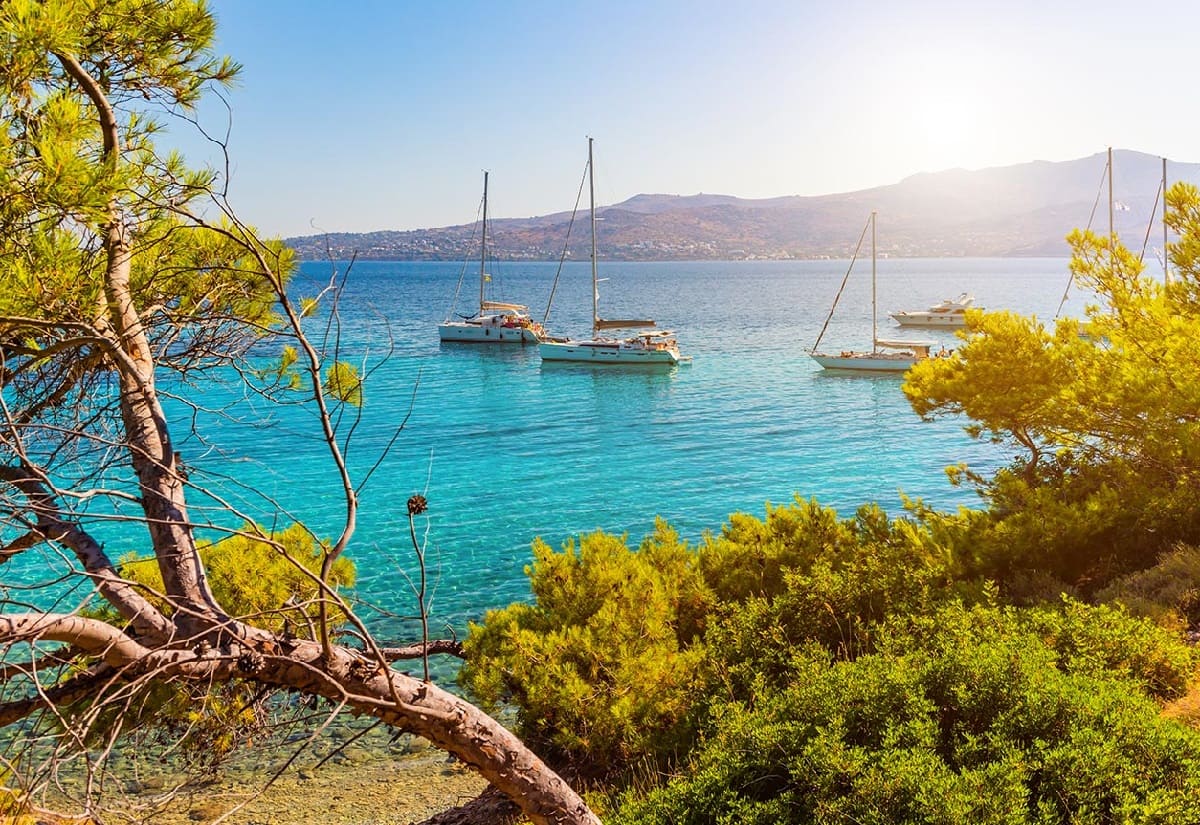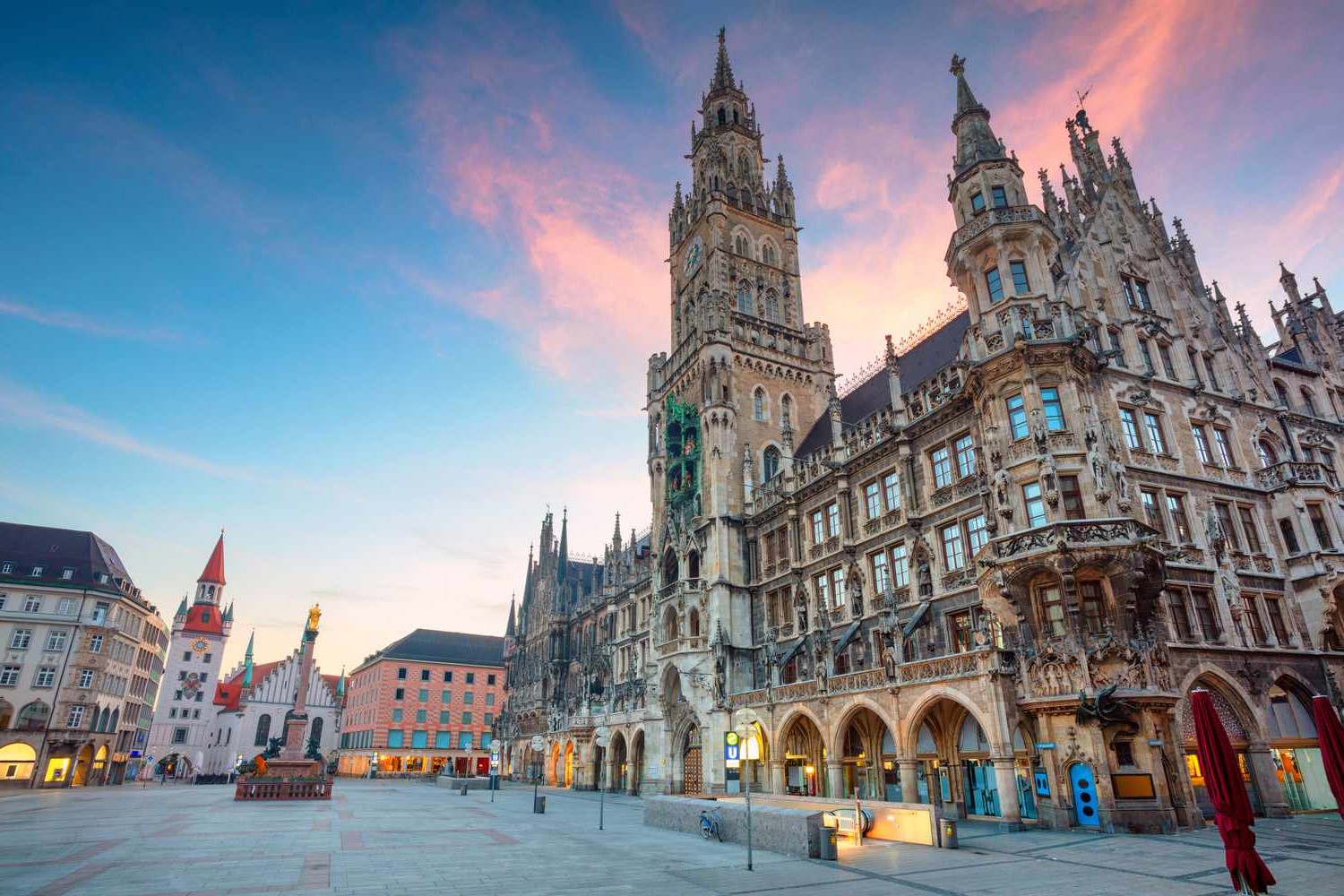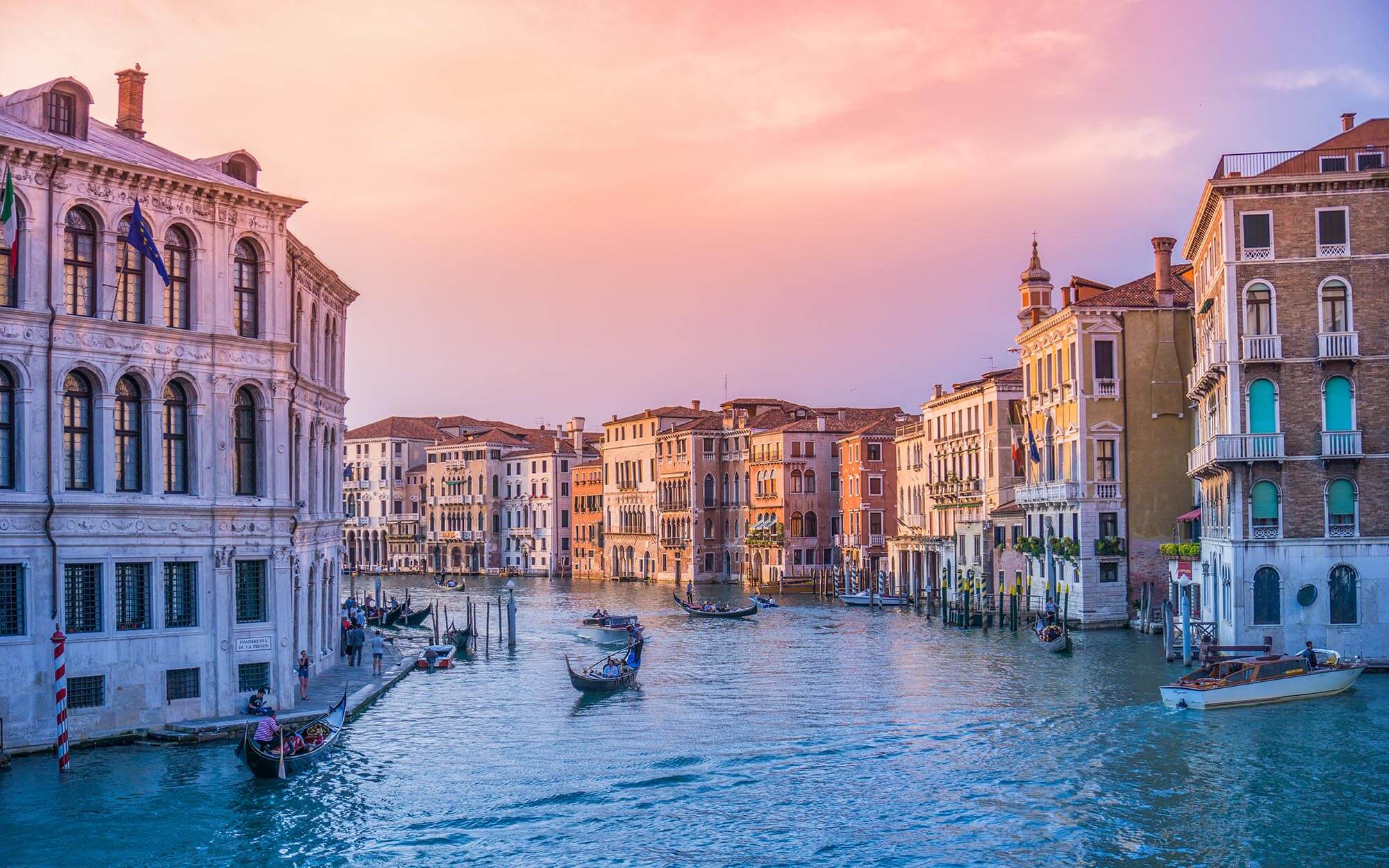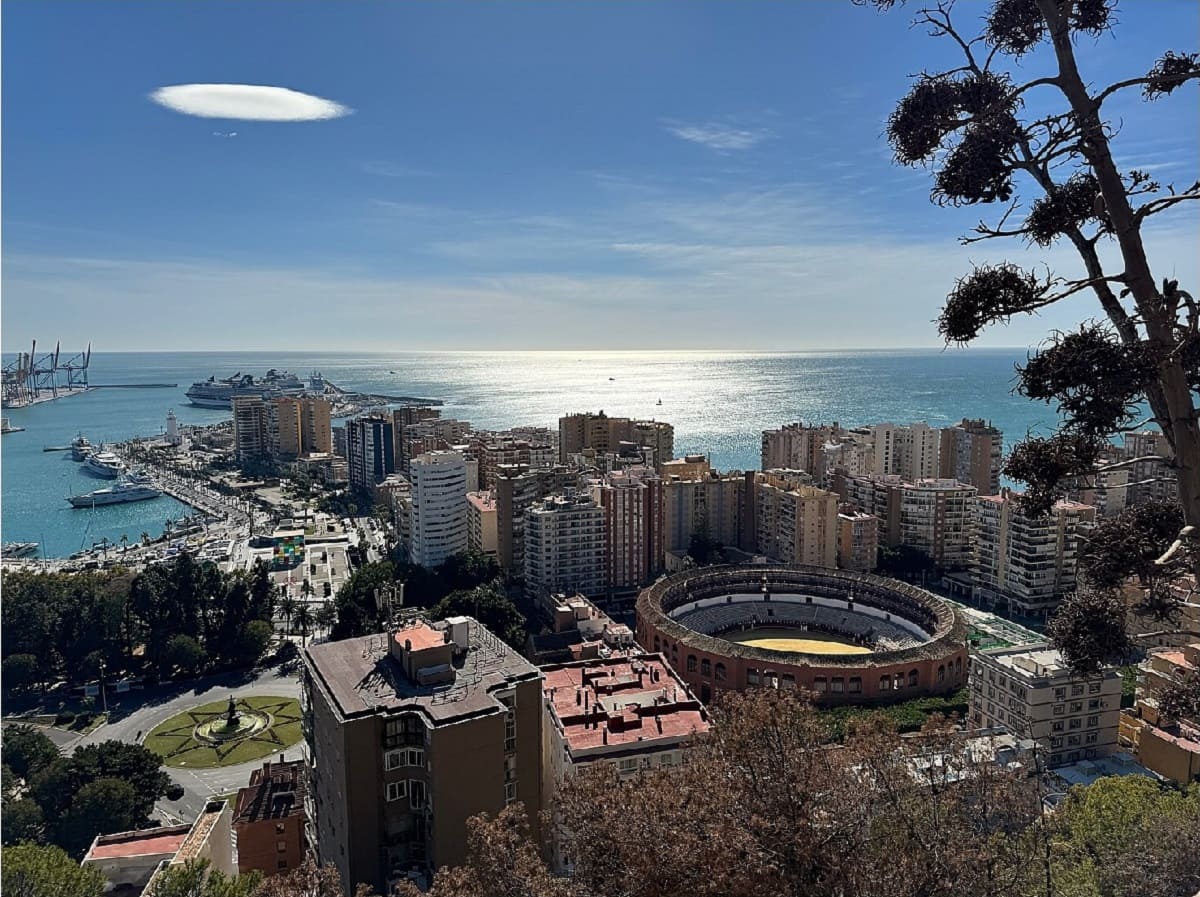Home>Weather and Climate>Monthly Mediterranean Weather Guide


Weather and Climate
Monthly Mediterranean Weather Guide
Published: March 7, 2024
Plan your travels with our comprehensive monthly Mediterranean weather guide. Learn about the weather and climate to make the most of your trip.
(Many of the links in this article redirect to a specific reviewed product. Your purchase of these products through affiliate links helps to generate commission for Temperatures.com, at no extra cost. Learn more)
Table of Contents
- Introduction
- Understanding Mediterranean Climate
- Weather Patterns in January
- Weather Patterns in February
- Weather Patterns in March
- Weather Patterns in April
- Weather Patterns in May
- Weather Patterns in June
- Weather Patterns in July
- Weather Patterns in August
- Weather Patterns in September
- Weather Patterns in October
- Weather Patterns in November
- Weather Patterns in December
- Conclusion
Introduction
The Mediterranean region is renowned for its stunning landscapes, rich history, and diverse cultures. One of the defining features of this captivating area is its unique climate, which greatly influences the lifestyle, agriculture, and tourism of the region. Understanding the weather patterns in the Mediterranean is essential for residents, travelers, and businesses alike. In this comprehensive guide, we will delve into the monthly weather variations in the Mediterranean, providing valuable insights for those seeking to explore or settle in this enchanting part of the world.
The Mediterranean climate is characterized by hot, dry summers and mild, wet winters, creating a stark contrast between the seasons. This distinctive climate is influenced by the geographical features of the region, including the surrounding sea, mountain ranges, and latitude. The interplay of these factors results in a climate that is both predictable and diverse, offering a range of experiences throughout the year.
From the sun-kissed beaches of the French Riviera to the ancient ruins of Greece, the Mediterranean region is a treasure trove of natural beauty and historical wonders. Whether you are planning a summer vacation, considering a move to the area, or simply intrigued by the intricacies of climate, this guide will provide you with a detailed understanding of the weather patterns that shape the Mediterranean throughout the year. So, let's embark on a journey through the changing seasons of the Mediterranean and uncover the fascinating nuances of its climate.
Read more: Memphis Monthly Weather Guide
Understanding Mediterranean Climate
The Mediterranean climate is renowned for its distinct characteristics, which have a profound impact on the region's ecosystems, agriculture, and way of life. This climate is primarily characterized by hot, dry summers and mild, wet winters, creating a stark contrast between the seasons. The geographical features of the Mediterranean region, including its proximity to the Mediterranean Sea, mountain ranges, and latitude, play a pivotal role in shaping its climate.
During the summer months, the Mediterranean region experiences prolonged periods of sunshine and limited rainfall. The combination of high temperatures and low precipitation creates arid conditions, which are conducive to the cultivation of drought-resistant crops such as olives, grapes, and citrus fruits. The warm, dry summers also attract millions of tourists to the Mediterranean each year, seeking the idyllic beaches and vibrant coastal towns that epitomize the summer experience in this region.
In contrast, the winter months bring a significant shift in weather patterns, with cooler temperatures and increased rainfall. The Mediterranean's mild winters are a result of the moderating influence of the surrounding sea, which helps to regulate temperature extremes. The rainfall during this season sustains the region's diverse flora, including lush forests, vibrant wildflowers, and fertile agricultural lands. The winter rains also replenish the water sources, essential for supporting the region's ecosystems and human settlements.
The Mediterranean climate's unique characteristics have also contributed to the development of distinctive cultural practices and architectural styles. The traditional whitewashed buildings with flat roofs and shaded courtyards are designed to provide respite from the intense summer heat, while the terraced vineyards and olive groves showcase the ingenuity of agricultural practices adapted to the climate.
Overall, the Mediterranean climate is a defining feature of the region, shaping its landscapes, economies, and cultural heritage. Understanding the nuances of this climate is essential for residents, businesses, and travelers, as it provides valuable insights into the rhythm of life in the Mediterranean throughout the year.
Weather Patterns in January
In January, the Mediterranean region experiences a transition from the festive cheer of the holiday season to a period characterized by distinct weather patterns. This month marks the peak of winter, bringing cooler temperatures and increased precipitation to many parts of the Mediterranean. The weather patterns in January vary across the region, reflecting the diverse landscapes and geographical features that define the Mediterranean climate.
Southern Mediterranean destinations such as Malta, Cyprus, and the southern coasts of Spain and Italy typically experience milder winter conditions compared to their northern counterparts. In these areas, January brings relatively moderate temperatures, with daytime highs ranging from 10°C to 15°C (50°F to 59°F). While these regions may still receive occasional rainfall, the overall climate remains relatively mild, making them appealing destinations for travelers seeking a winter escape.
Conversely, the northern Mediterranean regions, including southern France, northern Italy, and parts of Greece, often encounter cooler and wetter conditions in January. Temperatures in these areas can range from 5°C to 10°C (41°F to 50°F), with higher elevations experiencing colder weather and occasional snowfall. The winter rains contribute to the lush greenery that characterizes the Mediterranean landscapes during this season, creating a picturesque backdrop for those exploring the region.
The islands of Corsica and Sardinia also witness unique weather patterns in January, with milder temperatures and a mix of sunny days and occasional showers. These islands offer a tranquil retreat for visitors seeking a balance between outdoor exploration and relaxation, as the weather allows for leisurely walks along the rugged coastlines and through the charming towns that dot the islands.
Overall, January in the Mediterranean presents a diverse tapestry of weather patterns, offering something for every traveler's preference. Whether it's the mild climate of the southern shores or the scenic beauty of the northern landscapes, the Mediterranean in January invites exploration and appreciation of its winter charms.
Weather Patterns in February
As February unfolds, the Mediterranean region experiences a continuation of the winter season, with varying weather patterns that showcase the diversity of this captivating area. From the sun-kissed shores of the southern Mediterranean to the snow-dusted landscapes of the northern regions, February offers a mosaic of climates that cater to a wide range of preferences.
In the southern Mediterranean, including destinations such as Malta, Cyprus, and the southern coasts of Spain and Italy, February brings a gradual transition from the cooler temperatures of January to milder, more pleasant conditions. Daytime highs typically range from 12°C to 16°C (54°F to 61°F), offering an inviting climate for outdoor activities and exploration. The occasional rainfall contributes to the rejuvenation of the natural landscapes, painting the surroundings with vibrant hues of green and providing a refreshing ambiance for travelers.
Moving northward, the weather patterns in February take on a different character, with regions such as southern France, northern Italy, and parts of Greece experiencing cooler temperatures and intermittent rainfall. The average daytime temperatures in these areas range from 8°C to 12°C (46°F to 54°F), creating an atmosphere that is ideal for leisurely strolls through historic towns and picturesque countryside. The winter rains continue to nourish the earth, sustaining the region's rich biodiversity and contributing to the allure of the Mediterranean's winter charm.
In the mountainous areas of the northern Mediterranean, including the Alps and Pyrenees, February brings a blanket of snow that transforms the landscapes into a winter wonderland. The snow-capped peaks and pristine slopes attract winter sports enthusiasts, offering opportunities for skiing, snowboarding, and other alpine activities. The crisp mountain air and breathtaking vistas make February an enchanting time to experience the natural beauty of the Mediterranean from a different perspective.
The islands of Corsica and Sardinia also embrace the arrival of February with a blend of mild temperatures and occasional showers, creating an ambiance that is conducive to both outdoor adventures and moments of relaxation. The rugged coastlines and charming villages beckon visitors to immerse themselves in the timeless allure of these Mediterranean gems, where the convergence of natural beauty and cultural heritage is truly captivating.
In essence, February in the Mediterranean encapsulates the essence of winter, offering a tapestry of weather patterns that cater to diverse interests and preferences. Whether it's the mild climate of the southern shores, the scenic beauty of the northern landscapes, or the snowy splendor of the mountainous regions, the Mediterranean in February invites exploration and appreciation of its winter charms.
Weather Patterns in March
March heralds the gradual transition from winter to spring in the Mediterranean, bringing a sense of renewal and anticipation for the warmer months ahead. This pivotal month showcases a diverse array of weather patterns across the region, reflecting the unique geographical features and climatic nuances that define the Mediterranean.
In the southern Mediterranean, including destinations such as Malta, Cyprus, and the southern coasts of Spain and Italy, March marks the emergence of milder temperatures and an increasing abundance of sunshine. Daytime highs typically range from 15°C to 18°C (59°F to 64°F), creating an inviting atmosphere for outdoor activities and exploration. The Mediterranean landscapes come alive with the vibrant colors of blooming wildflowers and lush vegetation, offering a picturesque backdrop for travelers seeking to immerse themselves in the natural beauty of the region.
Moving northward, regions such as southern France, northern Italy, and parts of Greece experience a gradual transition towards spring, with temperatures ranging from 10°C to 15°C (50°F to 59°F). The intermittent rainfall contributes to the rejuvenation of the countryside, nurturing the olive groves, vineyards, and citrus orchards that are emblematic of the Mediterranean landscape. The pleasant climate and longer daylight hours create an ideal setting for leisurely explorations of historic sites, coastal trails, and charming villages, allowing visitors to savor the timeless allure of the Mediterranean in the early stages of spring.
In the mountainous areas of the northern Mediterranean, including the Alps and Pyrenees, March brings a captivating transformation as the snow begins to recede, revealing the rugged terrain beneath. The melting snow gives rise to gushing streams and cascading waterfalls, adding a dynamic element to the mountain landscapes. The alpine meadows burst into bloom, showcasing a kaleidoscope of wildflowers and heralding the onset of the spring season in the highlands. This transition creates an enchanting backdrop for hikers, nature enthusiasts, and photographers, who are drawn to the unique spectacle of nature awakening from its winter slumber.
The islands of Corsica and Sardinia also embrace the arrival of March with a delightful blend of mild temperatures and increasing sunshine, offering an idyllic setting for outdoor pursuits and cultural explorations. The coastal paths, ancient ruins, and traditional villages beckon visitors to embrace the timeless charm of these Mediterranean gems, where the convergence of natural beauty and cultural heritage is truly captivating.
In essence, March in the Mediterranean epitomizes the spirit of transition and renewal, offering a tapestry of weather patterns that herald the arrival of spring. Whether it's the blossoming landscapes of the southern shores, the gradual awakening of the northern regions, or the dynamic transformation of the mountainous areas, the Mediterranean in March invites exploration and appreciation of its evolving seasonal splendor.
Read more: Duluth Monthly Weather Guide
Weather Patterns in April
April marks a significant turning point in the Mediterranean, as the region transitions into the full embrace of spring. This pivotal month brings a tapestry of weather patterns that reflect the diverse landscapes and climatic nuances of the Mediterranean, offering a captivating array of experiences for residents and travelers alike.
In the southern Mediterranean, including destinations such as Malta, Cyprus, and the southern coasts of Spain and Italy, April heralds the arrival of balmy temperatures and an abundance of sunshine. Daytime highs typically range from 18°C to 22°C (64°F to 72°F), creating an inviting atmosphere for outdoor pursuits and leisurely explorations. The Mediterranean landscapes burst into bloom, adorned with a kaleidoscope of wildflowers, blossoming trees, and vibrant coastal flora. The azure waters beckon visitors to indulge in seaside activities, from leisurely strolls along the shore to exhilarating water sports, offering a rejuvenating escape for those seeking the embrace of spring.
Moving northward, regions such as southern France, northern Italy, and parts of Greece experience a gradual transition towards milder temperatures, with daytime highs ranging from 15°C to 20°C (59°F to 68°F). The intermittent rainfall sustains the verdant countryside, nurturing the vineyards, olive groves, and pastoral landscapes that define the Mediterranean hinterlands. The longer daylight hours and pleasant climate create an ideal setting for cultural explorations, culinary adventures, and outdoor escapades, inviting visitors to immerse themselves in the timeless allure of the Mediterranean in the full bloom of spring.
In the mountainous areas of the northern Mediterranean, including the Alps and Pyrenees, April unveils a breathtaking transformation as the snow continues to recede, revealing the rugged terrain and alpine meadows in their full splendor. The high-altitude trails become accessible to hikers and nature enthusiasts, offering unparalleled vistas of snow-capped peaks, blooming wildflowers, and pristine alpine lakes. The mountain landscapes provide a sanctuary for those seeking a harmonious communion with nature, where the crisp mountain air and the symphony of natural wonders create an unforgettable backdrop for exploration and contemplation.
The islands of Corsica and Sardinia also embrace the arrival of April with a delightful blend of mild temperatures and increasing sunshine, inviting visitors to savor the timeless charm of these Mediterranean gems. The coastal paths, ancient ruins, and traditional villages beckon travelers to immerse themselves in the rich tapestry of history and natural beauty, where the convergence of cultural heritage and scenic landscapes creates an enchanting tableau of discovery and delight.
In essence, April in the Mediterranean epitomizes the spirit of renewal and abundance, offering a tapestry of weather patterns that herald the arrival of spring in all its splendor. Whether it's the blossoming landscapes of the southern shores, the gradual awakening of the northern regions, or the dynamic transformation of the mountainous areas, the Mediterranean in April invites exploration and appreciation of its evolving seasonal charm.
Weather Patterns in May
May heralds the arrival of spring in full bloom across the Mediterranean, ushering in a tapestry of weather patterns that epitomize the region's diverse landscapes and climatic nuances. This pivotal month offers a captivating array of experiences for residents and travelers, showcasing the Mediterranean at its most vibrant and inviting.
In the southern Mediterranean, including destinations such as Malta, Cyprus, and the southern coasts of Spain and Italy, May brings balmy temperatures and an abundance of sunshine. Daytime highs typically range from 22°C to 26°C (72°F to 79°F), creating an idyllic atmosphere for outdoor pursuits and leisurely explorations. The Mediterranean landscapes are adorned with a profusion of wildflowers, blossoming trees, and vibrant coastal flora, painting a picturesque backdrop for travelers seeking the embrace of spring. The azure waters beckon visitors to indulge in seaside activities, from leisurely strolls along the shore to exhilarating water sports, offering a rejuvenating escape for those seeking the quintessential Mediterranean experience.
Moving northward, regions such as southern France, northern Italy, and parts of Greece experience a delightful transition towards warmer temperatures, with daytime highs ranging from 20°C to 24°C (68°F to 75°F). The intermittent rainfall sustains the verdant countryside, nurturing the vineyards, olive groves, and pastoral landscapes that define the Mediterranean hinterlands. The longer daylight hours and pleasant climate create an ideal setting for cultural explorations, culinary adventures, and outdoor escapades, inviting visitors to immerse themselves in the timeless allure of the Mediterranean in the full bloom of spring.
In the mountainous areas of the northern Mediterranean, including the Alps and Pyrenees, May unveils a breathtaking transformation as the snow continues to recede, revealing the rugged terrain and alpine meadows in their full splendor. The high-altitude trails become accessible to hikers and nature enthusiasts, offering unparalleled vistas of snow-capped peaks, blooming wildflowers, and pristine alpine lakes. The mountain landscapes provide a sanctuary for those seeking a harmonious communion with nature, where the crisp mountain air and the symphony of natural wonders create an unforgettable backdrop for exploration and contemplation.
The islands of Corsica and Sardinia also embrace the arrival of May with a delightful blend of mild temperatures and increasing sunshine, inviting visitors to savor the timeless charm of these Mediterranean gems. The coastal paths, ancient ruins, and traditional villages beckon travelers to immerse themselves in the rich tapestry of history and natural beauty, where the convergence of cultural heritage and scenic landscapes creates an enchanting tableau of discovery and delight.
In essence, May in the Mediterranean epitomizes the spirit of renewal and abundance, offering a tapestry of weather patterns that herald the arrival of spring in all its splendor. Whether it's the blossoming landscapes of the southern shores, the gradual awakening of the northern regions, or the dynamic transformation of the mountainous areas, the Mediterranean in May invites exploration and appreciation of its evolving seasonal charm.
Weather Patterns in June
June ushers in the height of summer across the Mediterranean, bringing a tapestry of weather patterns that epitomize the region's diverse landscapes and climatic nuances. This pivotal month offers a captivating array of experiences for residents and travelers, showcasing the Mediterranean at its most vibrant and inviting.
In the southern Mediterranean, including destinations such as Malta, Cyprus, and the southern coasts of Spain and Italy, June heralds the arrival of warm temperatures and an abundance of sunshine. Daytime highs typically range from 26°C to 30°C (79°F to 86°F), creating an idyllic atmosphere for beachgoers and outdoor enthusiasts. The azure waters beckon visitors to indulge in seaside activities, from leisurely strolls along the shore to exhilarating water sports, offering a rejuvenating escape for those seeking the quintessential Mediterranean experience. The balmy evenings provide the perfect backdrop for al fresco dining and cultural festivities, where the vibrant energy of the Mediterranean comes to life under the starlit skies.
Moving northward, regions such as southern France, northern Italy, and parts of Greece experience a delightful transition towards warmer temperatures, with daytime highs ranging from 24°C to 28°C (75°F to 82°F). The Mediterranean hinterlands come alive with the bounty of summer, as the vineyards, olive groves, and pastoral landscapes flourish under the sun's nurturing rays. The longer daylight hours and pleasant climate create an ideal setting for cultural explorations, culinary adventures, and outdoor escapades, inviting visitors to immerse themselves in the timeless allure of the Mediterranean in the full bloom of summer.
In the mountainous areas of the northern Mediterranean, including the Alps and Pyrenees, June unveils a breathtaking transformation as the high-altitude meadows burst into bloom, creating a vibrant tapestry of wildflowers and alpine flora. The snow-capped peaks provide a stunning contrast to the verdant landscapes, offering a picturesque backdrop for hikers and nature enthusiasts. The mountain landscapes provide a sanctuary for those seeking a harmonious communion with nature, where the crisp mountain air and the symphony of natural wonders create an unforgettable backdrop for exploration and contemplation.
The islands of Corsica and Sardinia also embrace the arrival of June with a delightful blend of warm temperatures and increasing sunshine, inviting visitors to savor the timeless charm of these Mediterranean gems. The coastal paths, ancient ruins, and traditional villages beckon travelers to immerse themselves in the rich tapestry of history and natural beauty, where the convergence of cultural heritage and scenic landscapes creates an enchanting tableau of discovery and delight.
In essence, June in the Mediterranean epitomizes the spirit of summer, offering a tapestry of weather patterns that herald the arrival of the season in all its splendor. Whether it's the sun-drenched shores of the southern Mediterranean, the verdant landscapes of the northern regions, or the vibrant blooms of the mountainous areas, the Mediterranean in June invites exploration and appreciation of its evolving seasonal charm.
Weather Patterns in July
July marks the pinnacle of summer in the Mediterranean, enveloping the region in a tapestry of weather patterns that epitomize the essence of the season. From the sun-drenched shores to the lush hinterlands and mountainous landscapes, July offers a captivating array of experiences for residents and travelers, showcasing the Mediterranean at its most vibrant and inviting.
In the southern Mediterranean, including destinations such as Malta, Cyprus, and the southern coasts of Spain and Italy, July heralds the arrival of warm temperatures and an abundance of sunshine. Daytime highs typically range from 28°C to 32°C (82°F to 90°F), creating an idyllic atmosphere for beachgoers and outdoor enthusiasts. The azure waters beckon visitors to indulge in seaside activities, from leisurely strolls along the shore to exhilarating water sports, offering a rejuvenating escape for those seeking the quintessential Mediterranean experience. The balmy evenings provide the perfect backdrop for al fresco dining and cultural festivities, where the vibrant energy of the Mediterranean comes to life under the starlit skies.
Moving northward, regions such as southern France, northern Italy, and parts of Greece experience a delightful transition towards warmer temperatures, with daytime highs ranging from 26°C to 30°C (79°F to 86°F). The Mediterranean hinterlands come alive with the bounty of summer, as the vineyards, olive groves, and pastoral landscapes flourish under the sun's nurturing rays. The longer daylight hours and pleasant climate create an ideal setting for cultural explorations, culinary adventures, and outdoor escapades, inviting visitors to immerse themselves in the timeless allure of the Mediterranean in the full bloom of summer.
In the mountainous areas of the northern Mediterranean, including the Alps and Pyrenees, July unveils a breathtaking transformation as the high-altitude meadows burst into bloom, creating a vibrant tapestry of wildflowers and alpine flora. The snow-capped peaks provide a stunning contrast to the verdant landscapes, offering a picturesque backdrop for hikers and nature enthusiasts. The mountain landscapes provide a sanctuary for those seeking a harmonious communion with nature, where the crisp mountain air and the symphony of natural wonders create an unforgettable backdrop for exploration and contemplation.
The islands of Corsica and Sardinia also embrace the arrival of July with a delightful blend of warm temperatures and increasing sunshine, inviting visitors to savor the timeless charm of these Mediterranean gems. The coastal paths, ancient ruins, and traditional villages beckon travelers to immerse themselves in the rich tapestry of history and natural beauty, where the convergence of cultural heritage and scenic landscapes creates an enchanting tableau of discovery and delight.
In essence, July in the Mediterranean epitomizes the spirit of summer, offering a tapestry of weather patterns that herald the arrival of the season in all its splendor. Whether it's the sun-drenched shores of the southern Mediterranean, the verdant landscapes of the northern regions, or the vibrant blooms of the mountainous areas, the Mediterranean in July invites exploration and appreciation of its evolving seasonal charm.
Read more: Asheville Weather: Monthly Climate Guide
Weather Patterns in August
August signifies the peak of summer in the Mediterranean, enveloping the region in a tapestry of weather patterns that epitomize the essence of the season. From the sun-drenched shores to the lush hinterlands and mountainous landscapes, August offers a captivating array of experiences for residents and travelers, showcasing the Mediterranean at its most vibrant and inviting.
In the southern Mediterranean, including destinations such as Malta, Cyprus, and the southern coasts of Spain and Italy, August heralds the arrival of warm temperatures and an abundance of sunshine. Daytime highs typically range from 28°C to 32°C (82°F to 90°F), creating an idyllic atmosphere for beachgoers and outdoor enthusiasts. The azure waters beckon visitors to indulge in seaside activities, from leisurely strolls along the shore to exhilarating water sports, offering a rejuvenating escape for those seeking the quintessential Mediterranean experience. The balmy evenings provide the perfect backdrop for al fresco dining and cultural festivities, where the vibrant energy of the Mediterranean comes to life under the starlit skies.
Moving northward, regions such as southern France, northern Italy, and parts of Greece experience a delightful transition towards warmer temperatures, with daytime highs ranging from 26°C to 30°C (79°F to 86°F). The Mediterranean hinterlands come alive with the bounty of summer, as the vineyards, olive groves, and pastoral landscapes flourish under the sun's nurturing rays. The longer daylight hours and pleasant climate create an ideal setting for cultural explorations, culinary adventures, and outdoor escapades, inviting visitors to immerse themselves in the timeless allure of the Mediterranean in the full bloom of summer.
In the mountainous areas of the northern Mediterranean, including the Alps and Pyrenees, August unveils a breathtaking transformation as the high-altitude meadows burst into bloom, creating a vibrant tapestry of wildflowers and alpine flora. The snow-capped peaks provide a stunning contrast to the verdant landscapes, offering a picturesque backdrop for hikers and nature enthusiasts. The mountain landscapes provide a sanctuary for those seeking a harmonious communion with nature, where the crisp mountain air and the symphony of natural wonders create an unforgettable backdrop for exploration and contemplation.
The islands of Corsica and Sardinia also embrace the arrival of August with a delightful blend of warm temperatures and increasing sunshine, inviting visitors to savor the timeless charm of these Mediterranean gems. The coastal paths, ancient ruins, and traditional villages beckon travelers to immerse themselves in the rich tapestry of history and natural beauty, where the convergence of cultural heritage and scenic landscapes creates an enchanting tableau of discovery and delight.
In essence, August in the Mediterranean epitomizes the spirit of summer, offering a tapestry of weather patterns that herald the arrival of the season in all its splendor. Whether it's the sun-drenched shores of the southern Mediterranean, the verdant landscapes of the northern regions, or the vibrant blooms of the mountainous areas, the Mediterranean in August invites exploration and appreciation of its evolving seasonal charm.
Weather Patterns in September
September marks a transitional period in the Mediterranean, as the region gradually shifts from the peak of summer to the onset of autumn. This pivotal month brings a tapestry of weather patterns that reflect the diverse landscapes and climatic nuances of the Mediterranean, offering a captivating array of experiences for residents and travelers alike.
In the southern Mediterranean, including destinations such as Malta, Cyprus, and the southern coasts of Spain and Italy, September offers a delightful blend of warm temperatures and decreasing humidity. Daytime highs typically range from 25°C to 29°C (77°F to 84°F), creating an inviting atmosphere for outdoor pursuits and leisurely explorations. The azure waters retain their warmth, beckoning visitors to indulge in seaside activities and bask in the lingering summer sunshine. The coastal towns and villages exude a relaxed ambiance, where travelers can savor the last moments of summer against the backdrop of picturesque landscapes and cultural festivities.
Moving northward, regions such as southern France, northern Italy, and parts of Greece experience a gradual transition towards milder temperatures, with daytime highs ranging from 23°C to 27°C (73°F to 81°F). The Mediterranean hinterlands continue to showcase the bounty of late summer, as the vineyards, olive groves, and pastoral landscapes retain their verdant allure. The golden hues of the late summer sun cast a warm glow over the countryside, creating an ideal setting for leisurely explorations and culinary indulgences. The historic sites and rural retreats beckon visitors to immerse themselves in the timeless allure of the Mediterranean in the gentle embrace of early autumn.
In the mountainous areas of the northern Mediterranean, including the Alps and Pyrenees, September unveils a captivating transformation as the high-altitude meadows transition from the vibrant blooms of summer to the golden hues of early autumn. The crisp mountain air carries a hint of anticipation for the changing season, as hikers and nature enthusiasts revel in the tranquil beauty of the alpine landscapes. The mountain landscapes provide a sanctuary for those seeking a harmonious communion with nature, where the transition from summer to autumn unfolds in a symphony of natural wonders.
The islands of Corsica and Sardinia also embrace the arrival of September with a delightful blend of warm temperatures and decreasing crowds, inviting visitors to savor the timeless charm of these Mediterranean gems. The coastal paths, ancient ruins, and traditional villages offer a serene backdrop for cultural explorations and moments of relaxation, where the convergence of natural beauty and historical heritage creates an enchanting tableau of discovery and delight.
In essence, September in the Mediterranean epitomizes the spirit of transition and lingering warmth, offering a tapestry of weather patterns that herald the gradual shift from summer to autumn. Whether it's the sun-kissed shores of the southern Mediterranean, the gentle embrace of early autumn in the northern regions, or the tranquil beauty of the mountainous areas, the Mediterranean in September invites exploration and appreciation of its evolving seasonal charm.
Weather Patterns in October
October marks a significant transition in the Mediterranean, as the region bids farewell to the lingering warmth of summer and embraces the gradual onset of autumn. This pivotal month brings a tapestry of weather patterns that reflect the diverse landscapes and climatic nuances of the Mediterranean, offering a captivating array of experiences for residents and travelers alike.
In the southern Mediterranean, including destinations such as Malta, Cyprus, and the southern coasts of Spain and Italy, October ushers in a gentle cooling of temperatures, creating an inviting atmosphere for outdoor pursuits and cultural explorations. Daytime highs typically range from 20°C to 24°C (68°F to 75°F), providing a comfortable backdrop for leisurely strolls along the sun-kissed shores and through the historic streets of coastal towns. The azure waters retain their allure, inviting visitors to savor the last moments of beachside relaxation before the arrival of autumn's embrace. The coastal landscapes exude a tranquil ambiance, where travelers can immerse themselves in the timeless allure of the Mediterranean against the backdrop of picturesque seascapes and cultural festivities.
Moving northward, regions such as southern France, northern Italy, and parts of Greece experience a gradual transition towards cooler temperatures, with daytime highs ranging from 18°C to 22°C (64°F to 72°F). The Mediterranean hinterlands undergo a subtle transformation, as the vineyards, olive groves, and pastoral landscapes embrace the changing season. The golden hues of autumn cast a warm glow over the countryside, creating an ideal setting for leisurely explorations and culinary indulgences. The historic sites and rural retreats beckon visitors to immerse themselves in the timeless allure of the Mediterranean in the gentle embrace of early autumn.
In the mountainous areas of the northern Mediterranean, including the Alps and Pyrenees, October unveils a captivating transformation as the high-altitude meadows transition from the vibrant blooms of summer to the golden hues of autumn. The crisp mountain air carries a hint of anticipation for the changing season, as hikers and nature enthusiasts revel in the tranquil beauty of the alpine landscapes. The mountain landscapes provide a sanctuary for those seeking a harmonious communion with nature, where the transition from summer to autumn unfolds in a symphony of natural wonders.
The islands of Corsica and Sardinia also embrace the arrival of October with a delightful blend of mild temperatures and a sense of tranquility, inviting visitors to savor the timeless charm of these Mediterranean gems. The coastal paths, ancient ruins, and traditional villages offer a serene backdrop for cultural explorations and moments of relaxation, where the convergence of natural beauty and historical heritage creates an enchanting tableau of discovery and delight.
In essence, October in the Mediterranean epitomizes the spirit of transition and the gentle embrace of autumn, offering a tapestry of weather patterns that herald the gradual shift from summer to fall. Whether it's the sun-kissed shores of the southern Mediterranean, the golden hues of early autumn in the northern regions, or the tranquil beauty of the mountainous areas, the Mediterranean in October invites exploration and appreciation of its evolving seasonal charm.
Weather Patterns in November
November brings a noticeable shift in the Mediterranean as the region transitions from the gentle embrace of autumn to the onset of winter. This month ushers in a tapestry of weather patterns that reflect the diverse landscapes and climatic nuances of the Mediterranean, offering a captivating array of experiences for residents and travelers alike.
In the southern Mediterranean, including destinations such as Malta, Cyprus, and the southern coasts of Spain and Italy, November introduces a gradual cooling of temperatures, creating a serene ambiance for outdoor pursuits and cultural explorations. Daytime highs typically range from 16°C to 20°C (61°F to 68°F), providing a comfortable backdrop for leisurely strolls along the sun-kissed shores and through the historic streets of coastal towns. The azure waters retain their allure, inviting visitors to savor the last moments of beachside relaxation before the arrival of winter's embrace. The coastal landscapes exude a tranquil ambiance, where travelers can immerse themselves in the timeless allure of the Mediterranean against the backdrop of picturesque seascapes and cultural festivities.
Moving northward, regions such as southern France, northern Italy, and parts of Greece experience a gradual transition towards cooler temperatures, with daytime highs ranging from 14°C to 18°C (57°F to 64°F). The Mediterranean hinterlands undergo a subtle transformation, as the vineyards, olive groves, and pastoral landscapes embrace the changing season. The golden hues of autumn cast a warm glow over the countryside, creating an ideal setting for leisurely explorations and culinary indulgences. The historic sites and rural retreats beckon visitors to immerse themselves in the timeless allure of the Mediterranean in the gentle embrace of early winter.
In the mountainous areas of the northern Mediterranean, including the Alps and Pyrenees, November unveils a captivating transformation as the high-altitude meadows transition from the golden hues of autumn to the pristine beauty of early winter. The crisp mountain air carries a hint of anticipation for the changing season, as hikers and nature enthusiasts revel in the tranquil beauty of the alpine landscapes. The mountain landscapes provide a sanctuary for those seeking a harmonious communion with nature, where the transition from autumn to winter unfolds in a symphony of natural wonders.
The islands of Corsica and Sardinia also embrace the arrival of November with a delightful blend of mild temperatures and a sense of tranquility, inviting visitors to savor the timeless charm of these Mediterranean gems. The coastal paths, ancient ruins, and traditional villages offer a serene backdrop for cultural explorations and moments of relaxation, where the convergence of natural beauty and historical heritage creates an enchanting tableau of discovery and delight.
In essence, November in the Mediterranean epitomizes the spirit of transition and the gentle embrace of early winter, offering a tapestry of weather patterns that herald the gradual shift from autumn to the onset of winter. Whether it's the serene shores of the southern Mediterranean, the golden hues of early winter in the northern regions, or the tranquil beauty of the mountainous areas, the Mediterranean in November invites exploration and appreciation of its evolving seasonal charm.
Read more: Naples Italy Weather: Monthly Climate Guide
Weather Patterns in December
December brings a distinct shift in the Mediterranean as the region transitions into the heart of winter. This pivotal month ushers in a tapestry of weather patterns that reflect the diverse landscapes and climatic nuances of the Mediterranean, offering a captivating array of experiences for residents and travelers alike.
In the southern Mediterranean, including destinations such as Malta, Cyprus, and the southern coasts of Spain and Italy, December introduces a noticeable drop in temperatures, creating a serene ambiance for outdoor pursuits and cultural explorations. Daytime highs typically range from 12°C to 16°C (54°F to 61°F), providing a comfortable backdrop for leisurely strolls along the sun-kissed shores and through the historic streets of coastal towns. The azure waters retain their allure, inviting visitors to savor the last moments of beachside relaxation before the arrival of winter's embrace. The coastal landscapes exude a tranquil ambiance, where travelers can immerse themselves in the timeless allure of the Mediterranean against the backdrop of picturesque seascapes and cultural festivities.
Moving northward, regions such as southern France, northern Italy, and parts of Greece experience a gradual transition towards cooler temperatures, with daytime highs ranging from 10°C to 14°C (50°F to 57°F). The Mediterranean hinterlands undergo a subtle transformation, as the vineyards, olive groves, and pastoral landscapes embrace the changing season. The golden hues of autumn cast a warm glow over the countryside, creating an ideal setting for leisurely explorations and culinary indulgences. The historic sites and rural retreats beckon visitors to immerse themselves in the timeless allure of the Mediterranean in the gentle embrace of early winter.
In the mountainous areas of the northern Mediterranean, including the Alps and Pyrenees, December unveils a captivating transformation as the high-altitude meadows transition from the pristine beauty of early winter to the enchanting vistas of snow-dusted landscapes. The crisp mountain air carries a hint of anticipation for the winter season, as hikers and nature enthusiasts revel in the tranquil beauty of the alpine landscapes. The mountain landscapes provide a sanctuary for those seeking a harmonious communion with nature, where the transition from autumn to winter unfolds in a symphony of natural wonders.
The islands of Corsica and Sardinia also embrace the arrival of December with a delightful blend of mild temperatures and a sense of tranquility, inviting visitors to savor the timeless charm of these Mediterranean gems. The coastal paths, ancient ruins, and traditional villages offer a serene backdrop for cultural explorations and moments of relaxation, where the convergence of natural beauty and historical heritage creates an enchanting tableau of discovery and delight.
In essence, December in the Mediterranean epitomizes the spirit of transition and the gentle embrace of winter, offering a tapestry of weather patterns that herald the gradual shift from autumn to the onset of winter. Whether it's the serene shores of the southern Mediterranean, the snow-dusted landscapes of the northern regions, or the tranquil beauty of the mountainous areas, the Mediterranean in December invites exploration and appreciation of its evolving seasonal charm.
Conclusion
The Mediterranean region is a captivating tapestry of diverse landscapes, rich cultural heritage, and unique climatic nuances that shape the rhythm of life throughout the year. From the sun-drenched shores of the southern Mediterranean to the snow-dusted peaks of the northern regions, each month brings a distinctive array of weather patterns that cater to a wide range of preferences and experiences.
As the seasons unfold, the Mediterranean climate showcases its remarkable adaptability, offering a seamless transition from the vibrant warmth of summer to the tranquil beauty of winter. The unique interplay of geographical features, including the surrounding sea, mountain ranges, and latitude, contributes to the region's distinct climate, characterized by hot, dry summers and mild, wet winters.
The southern Mediterranean, encompassing destinations such as Malta, Cyprus, and the southern coasts of Spain and Italy, presents a delightful blend of warm temperatures, azure waters, and vibrant coastal flora. This region offers an inviting atmosphere for beachgoers and outdoor enthusiasts, creating an idyllic backdrop for leisurely explorations and cultural indulgences.
Moving northward, regions such as southern France, northern Italy, and parts of Greece showcase a gradual transition towards milder temperatures, where the Mediterranean hinterlands come alive with the bounty of summer and the golden hues of autumn. The vineyards, olive groves, and pastoral landscapes flourish under the sun's nurturing rays, providing an ideal setting for cultural explorations and culinary adventures.
In the mountainous areas of the northern Mediterranean, including the Alps and Pyrenees, the transition from summer to winter unfolds in a symphony of natural wonders. The high-altitude meadows burst into bloom, creating a vibrant tapestry of wildflowers and alpine flora, while the snow-dusted peaks offer a stunning contrast to the verdant landscapes, providing a sanctuary for those seeking a harmonious communion with nature.
The islands of Corsica and Sardinia embrace each season with a delightful blend of mild temperatures, inviting visitors to savor the timeless charm of these Mediterranean gems. The coastal paths, ancient ruins, and traditional villages offer a serene backdrop for cultural explorations and moments of relaxation, where the convergence of natural beauty and historical heritage creates an enchanting tableau of discovery and delight.
In essence, the Mediterranean climate offers a rich tapestry of weather patterns that cater to diverse interests and preferences, inviting exploration and appreciation of its evolving seasonal charm. Whether it's the sun-drenched shores of the southern Mediterranean, the verdant landscapes of the northern regions, or the tranquil beauty of the mountainous areas, the Mediterranean beckons travelers to immerse themselves in its timeless allure and discover the captivating nuances of its climate throughout the year.












